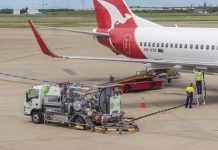Sustainable aviation fuels are coming. The UK should seize this opportunity, Andy Phillips, Aerospace Policy Advisor at ADS Group argues, as a contribution towards decarbonising aviation
Over the course of more than a century, aviation has made the world smaller than ever before by connecting people, places, and goods.
In that time, the aviation industry has undergone dramatic technological transformations: from the early days on a beach in North Carolina to the invention of the jet engine, supersonic travel, and a relentless drive for the next big leap in aerospace technology.
Decarbonising aviation by 2050 will require a new approach to aerospace research
The next transformational leap in aerospace will greatly accelerate the trend of the last few decades, improving efficiency and reducing aviation’s impact on the environment.
While modern aircraft are up to 25% more efficient than previous generations, meeting aviation’s globally agreed goal of net zero carbon emissions by 2050 will require a whole new approach to aerospace research and development.
The Aerospace Technology Institute’s (ATI) FlyZero research programme last year found that liquid hydrogen-powered aircraft offer a viable pathway to net zero.
Even the most optimistic timelines won’t see new propulsion techniques fuelled by novel fuels like hydrogen making a substantial impact until the late 2040s.
This is owing to new infrastructure required to be put in place globally and to allow time for new hydrogen-powered aircraft fleet to proliferate the global fleet.
Aviation’s net zero commitment, set out at the International Civil Aviation Organisation’s (ICAO) general meeting in 2022, will require significant investment in an alternative, more immediate form of technology: sustainable aviation fuels (SAF).
What are sustainable aviation fuels?
SAF is jet fuel derived from sustainable, alternate feedstocks. For a SAF to meet the criteria to be considered sustainable, they must meet certain targets on lifecycle carbon reductions, with the most advanced SAF technology offering the highest proportion of carbon removed.
Since sustainable aviation fuels are certified in the same way as traditional jet fuel, they are able to be used in most modern aircraft immediately, acting as a ‘drop-in’ fuel – so they are good to go now, without any major modifications required to the aircraft, the airport infrastructure, or supply pipelines.
With emissions reduction factors ranging from 70% to 100% (1), and in even in some cases more than 100%, SAF use at scale can have a meaningful impact in reducing aviation’s carbon emissions today. But that is the problem – achieving scale.
While many SAF production technologies are sufficiently mature and ready to be used, the primary challenge facing the aviation industry is how to scale the production of SAF around the world.
For that reason, SAF has become a key feature of many countries’ recent climate-related shifts in industrial policy. SAF tax credits and grants feature prominently in the U.S.’ Inflation Reduction Act (IRA), while the EU has set out its stall through the ReFuelEU research programme. Japan, Brazil, and Australia, among many others, are all following suit.
A sustainable aviation fuel mandate in the UK
In the UK, the Government has committed to introducing a SAF mandate, requiring that airlines operating in the UK use 10% SAF by 2030.
This is alongside funding programmes such as the Green Fuels, and Clean Skies competition awarding financial support for early-stage sustainable aviation fuel projects.
These policies will be a vital mechanism through which policymakers can develop a thriving SAF industry in the UK.
Given the clear global demand for SAF, with almost every major airline committing to increasing their proportion of SAF, the UK can develop a domestic industry producing SAF use at UK airports.
With effective policy support, a UK SAF production industry would support more than 10,000 jobs and generate nearly £1.8 billion in Gross Value Added to the UK economy by 2030. (2)
The SAF mandate is a welcome step in the right direction, but in order for the UK to reap the potential benefits of a domestic SAF industry, a Contracts for Difference (CfD) would be needed, to provide additional price certainty to SAF producers, encouraging them to choose the UK in light of the extremely competitive global environment.
Decarbonising aviation in the UK
Support for SAF will be just one part of decarbonising aviation in the UK.
The recently updated Sustainable Aviation Roadmap, produced by an industry coalition covering all parts of the aviation and aerospace sectors, found that, with an effective policy environment, SAF would make up 39% of UK aviation’s reduction in emissions to reach net zero by 2050.
Other levers, including replacing older aircraft with new generations, modernising the UK’s airspace and carbon removals, will also play a part, in addition to the exciting and revolutionary new technologies that aerospace manufacturers are developing.
But unquestionably, the sustainable aviation fuel opportunity before the UK now is excellent – the opportunity to improve the resilience of our jet fuel supply while producing greener, cleaner fuels at home, generating jobs and economic value across the country should not be missed.
Government action now, including the implementation of a CfD scheme, can secure the UK’s seat at the SAF table, ensuring that the UK is the destination of choice for investments in sustainable aviation.
References
- Waypoint 2050, Air Transport Action Group.
- Sustainable Aviation Roadmap 2023, p35.
















